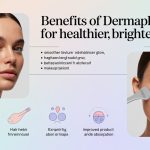Key Takeaways:
- Dermaplaning is a non-invasive exfoliation technique that removes dead skin cells and fine facial hair, resulting in smoother and more radiant-looking skin.
- Regular dermaplaning can enhance the absorption of skincare products, reduce the appearance of fine lines, and improve overall skin texture.
- While generally safe, it’s essential to follow proper aftercare and consult with a professional to minimize potential risks.
Understanding Dermaplaning
Dermaplaning is a gentle exfoliation technique that removes dead skin cells and fine facial hair using a sterile, surgical-grade blade. This non-invasive procedure helps create a smoother skin surface, allowing for better absorption of skincare products and a more even makeup application. It can also enhance skin brightness and texture, leaving the face looking refreshed and rejuvenated without the use of harsh chemicals or downtime.
Those interested in exploring professional skincare treatments may find that dermaplaning Virginia Beach clinics and similar providers elsewhere offer a safe and effective option for maintaining healthy, glowing skin. By promoting cell turnover and removing dull surface layers, dermaplaning supports long-term skin health. Regular treatments can help individuals achieve a more polished complexion and complement other facial rejuvenation methods.
Key Benefits of Dermaplaning

- Enhanced Skin Radiance:Dermaplaning removes surface build-up, revealing fresher skin and creating an immediately noticeable glow that improves with treatments.
- Smoother Skin Texture: Removing dead cells and vellus hair leaves skin velvety, facilitating better makeup application and a flawless finish.
- Improved Product Absorption:Without dead skin, skincare products can penetrate more deeply, increasing their effectiveness and enhancing the benefits of your routine.
- Reduction of Fine Lines: Dermaplaning promotes skin cell turnover, helping smooth fine lines and support anti-aging.
- Minimized Acne Scars:Although not suitable for active breakouts, it can help fade superficial scars and hyperpigmentation, thereby enhancing tone and texture.
Who Can Benefit from Dermaplaning?
Most individuals, regardless of age or skin type, can benefit from dermaplaning, enjoying instant radiance and smoother skin without the need for aggressive procedures. Sensitive skin benefits from its gentle nature, as it is less harsh than chemical exfoliants. Nonetheless, individuals with active acne, eczema, rosacea, or psoriasis should consult a dermatologist beforehand, as the scalpel may irritate sensitive or damaged skin, making a professional consultation crucial.
Professional vs. At-Home Dermaplaning
Dermaplaning can be performed professionally or at home. Professional services, offered by licensed aestheticians or dermatologists, utilize surgical-grade tools to achieve optimal results and minimize the risks of injury, infection, or uneven exfoliation. In contrast, at-home kits are generally less sharp and require careful technique to avoid cuts or irritation, necessitating the use of sanitized tools and strict adherence to instructions. For beginners or those with sensitive skin, it is recommended to start with professional sessions.
Post-Treatment Care

Proper aftercare following dermaplaning is crucial to maintain your results and protect the newly exposed layer of skin. Focus on keeping your skin hydrated using gentle, fragrance-free moisturizers or soothing serums enriched with hyaluronic acid and ceramides. Daily sun protection is essential—apply a broad-spectrum sunscreen with an SPF of 30 or higher to shield your skin from UV damage. For the first few days, avoid products containing retinoids, AHAs, or BHAs to prevent irritation and allow your skin time to recover and fully benefit from the treatment.
Potential Risks and Considerations
Dermaplaning is typically safe, but side effects such as redness, sensitivity, dry patches, or minor nicks can happen, usually resolving within one to two days. While infection is uncommon, it can occur if hygiene practices aren’t followed or if non-sterile tools are used. To achieve the best results and minimize risks, always consult a certified provider, inform them of any existing skin issues, and follow the aftercare guidelines carefully.
Conclusion
Dermaplaning provides a gentle, transformative approach to achieving healthier, brighter, and softer skin. By removing dead cells and facial hair, it dramatically boosts radiance while enhancing the effects of your skincare products and makeup. With the right candidate selection, professional execution, and diligent aftercare, this exfoliation technique can become a cornerstone of your self-care routine—helping you put your best face forward each day.









